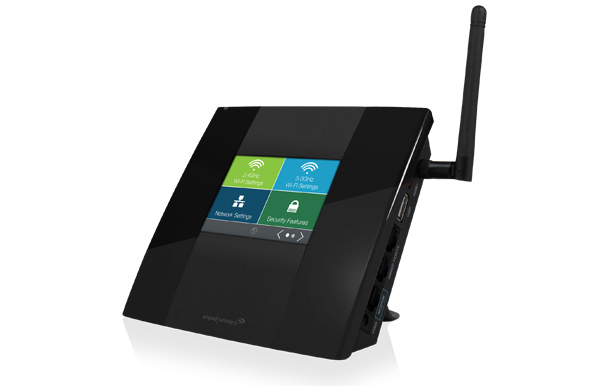Tom's Guide Verdict
It may not be the fastest router around, but the Amped Wireless TAP-R2 is one of the smallest, and its touch screen not only shows you what's going on with your network, but lets you tap to make changes.
Pros
- +
Compact router doesn't take up much space
- +
Handy touch-screen interface
- +
Tablet and phone apps for remotely monitoring the router
- +
Good range of configuration options
Cons
- -
Low performance
- -
Only two LAN connections rather than four
- -
Older USB 2.0 port instead of newer USB 3.0
Why you can trust Tom's Guide
While the $130 Amped Wireless TAP-R2 happens to be one of the smallest routers around, it has a bright touch screen for setup and configurations. It can also show the date and time, making it the rare router that you won't want to hide. Unfortunately, the TAP-R2's performance pales in comparison to other routers, making it a decent choice only for basic networking setups.
Design
One of the smallest routers on the market, Amped Wireless' black TAP-R2 measures 5.7 x 5.4 x 1.4 inches -- about half the size of Securifi’s Almond+ router (7.3 x 5.4 x 1.3 inches) and no bigger than a small paperback book. Along with an internal antenna, the TAP-R2 has a 4.5-inch removable stub antenna that you can rotate and swivel. The router comes with a plastic snap-on stand and has holes in the back if you decide to mount it to a wall.
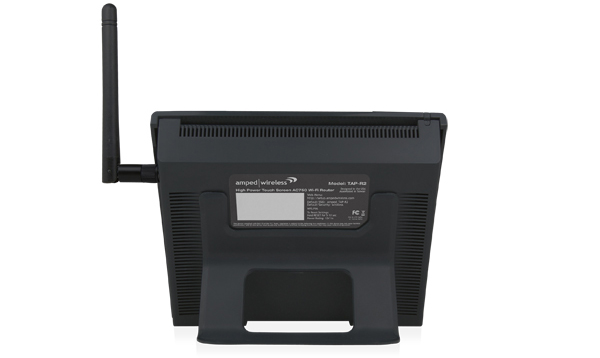
Like the Almond+, the TAP-R2 has a 3.5-inch touch screen with a 320 x 240 pixel resolution. Icons and text show up well on the display, but the screen is recessed by 0.1 inches, making it hard to tap it at times. As is the case with the Almond+, the Tap-R2 includes a stylus and a place to hide it.
Unlike most routers, the TAP-R2 has no flashing LEDs to distract you. Each screen holds a 2-by-2 grid of icons, half as many as the Almond+; you tap on an arrow to move between screens. You use the screen to adjust the settings, access the Setup Wizard or change the device's name.
MORE: Best Routers
Inside the TAP-R2, Amped Wireless' signature amplifiers boost the router's transmission power and reception sensitivity. This router has two 2.4GHz and one 5GHz amps for a total output of 800 milliwatts.
Unlike the Almond+, the TAP-R2 lacks home automation features that let you remotely control lamps, garage doors or thermostats. On the other hand, Amped has set the router up so that its screen shows the current time and date when it is idle, something the Almond+ doesn't offer. As a result, the TAP-R2 looks good enough to leave out in the open, something you can't say about many routers. You can easily turn off the screen.
While the Almond+ can be used as a router, access point or wireless bridge, the TAP-R2 needs to be manually configured as an access point. If you want a wireless extender, you'll need to buy the TAP-EX or TAP-EX2 instead. Rather than the expected quartet of LAN ports, the side panel of the TAP-R2 gets by with just two, which should be fine for light-duty work.
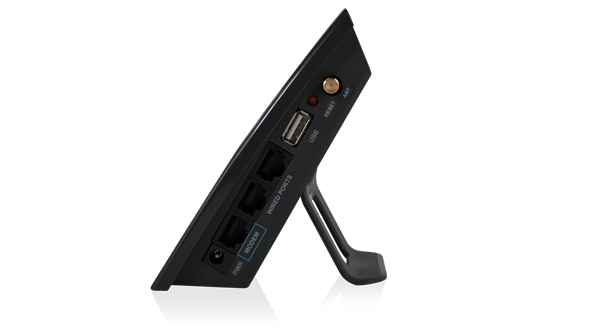
Like the Almond +, the TAP-R2 has a USB 2.0 port that can connect with a hard drive, but not an online printer. There's no on-off switch, but the router has a recessed reset button.
Setup
The TAP-R2 is one of the easiest routers to set up. You have the choice of configuring the router via its display or a connected client. After tapping the Setup Wizard, the screen walks you through a logical routine where you have the option of changing the network names and passcodes. It's a good idea because the router comes with an insecure setup. You can also use a computer to make these changes one at a time by pointing a client at "setup.ampedwireless.com," which opens the TAP-R2's Dashboard software. Figure on about five minutes to set up the device using either method. The system comes with an AC adapter, an Ethernet cable, a stand and a CD that contains the manual and Amped software.
Get instant access to breaking news, the hottest reviews, great deals and helpful tips.
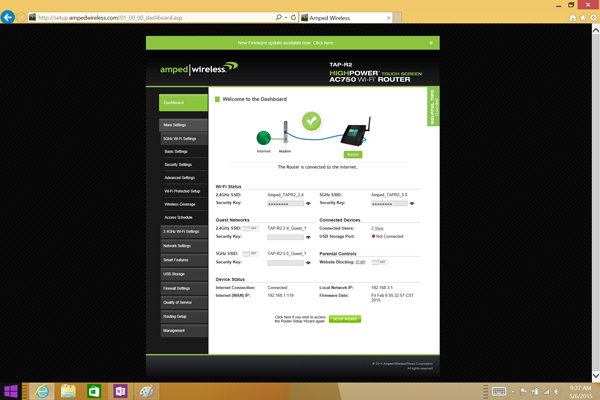
While the TAP-R2 can't operate as a Samba or DLNA server, you can use it as an FTP server. The router has good security with WEP, WPA, WPA2 and WPA2 mixed-mode encryption as well as a Stateful Packet Inspection and a Network Address Translation firewall. On the downside, the TAP-R2 can't use a Radius server to authenticate clients.
Over the course of a week, I used the TAP-R2 to connect a variety of clients, ranging from notebooks and tablets to printers and Network Attached Storage systems. If you have lots of people staying over, the router can create up to eight guest networks.
Software
You adjust the TAP-R2's settings either by tapping the router's screen or via a connected client. The latter approach offers more options. Using the screen, you can change network name, security settings and which channel you want to use, while a connected client can also do things like adjust the fragmentation threshold or beacon interval and enable beamforming. As is the case with the RTA1750 from Amped Wireless, you can adjust the router's power output to suit your environment.
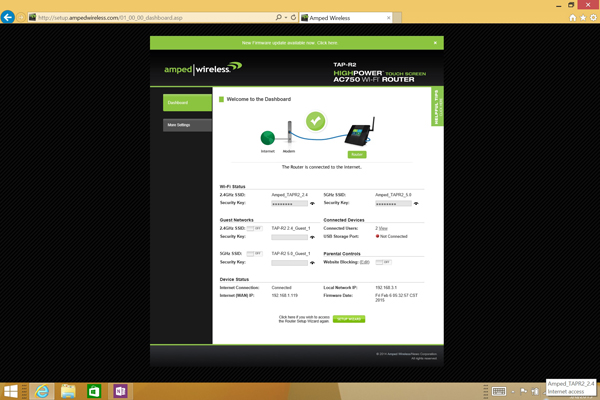
The TAP-R2 can block objectionable sites and has an access schedule so that kids can get some homework done. At any time you can see how hard the router is working by looking at its traffic statistics, but the information is tabular as opposed to shown in graphs.
The Tap-R2 has Quality of Service software that can be based on a Mac or an IP address and set up to deliver a minimum amount of bandwidth so that you can apportion specific amounts to bandwidth-hungry activities like gaming and streaming video.
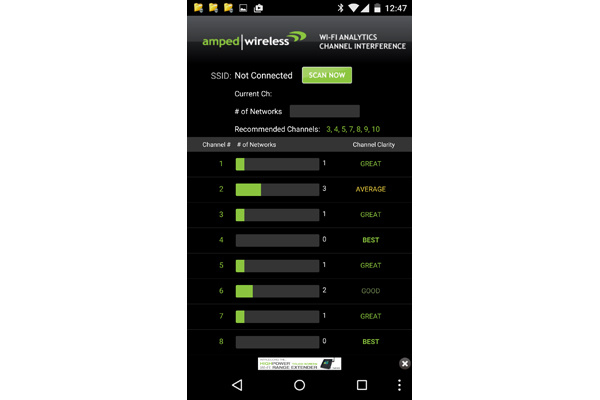
Amped's Wi-Fi Analytics Tool app is an excellent adjunct to the TAP-R2's software. It's available for free for Android systems and PCs, but not iOS devices. Not only can the software give a good overview of the network, including interfering LANs, it also shows which channels are being used.
Performance
The TAP-R2 runs on a 660MHz processor with 64MB of RAM and 8MB of flash storage space for its firmware and another 16MB for the touch screen. Both of the router's antennas can shape the transmitted beam to best suit the receiving system, but it does so without the latest MU-MIMO electronics, which shares bandwidth more efficiently to connected devices.
Capable of dual-band operations, the TAP-R2 can connect up to theoretical limits of 300 and 433Mbps over 2.4GHz and 5GHz connections for a total of 733Mbps, less than half the peak output of the Almond+. Based on real-world testing in our lab with IxChariot software, the TAP-R2 was able to move barely one-eighth that with a peak combined throughput of only 93.8Mbps at 5 feet. That's about one-quarter the average throughput for 802.11ac equipment of 368.38Mbps and the Almond+'s bandwidth of 363.5Mbps.

In 2.4GHz mode, it moved a mere 37.9Mbps at 5 feet, which is less than half the average of 73.7Mbps and well below the top gun in this area: The Netgear R8000's 97.8Mbps. While the TAP-R2 blew away the similarly priced Belkin F9K1118, it was off the pace set by its larger and more powerful cousin, the RTA1750. The 140-foot range of the TAP-R2 in 2.4GHz mode puts it at the bottom with the Trendnet TEW-812DRU.
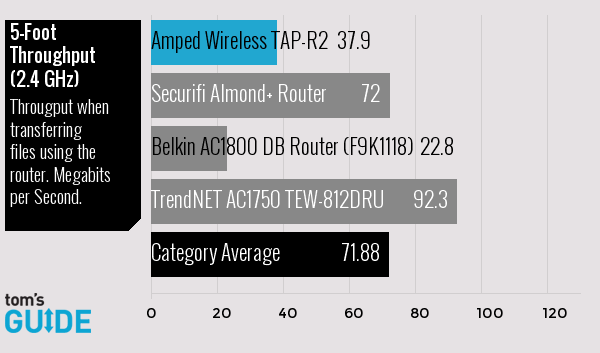
Using its 5GHz mode, the TAP-R2 really fell behind the competition with the ability to push 55.9Mbps, about one-fifth of the average (296.5Mbps). It was left in the dust by the class-leading Asus RTAC68U's ability to deliver 361.3Mbps.
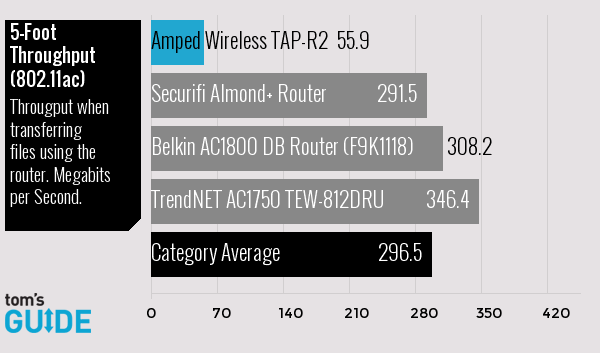
That said, if all you want to do is distribute an Internet connection throughout a home, the TAP-R2 should be fine. I used it for a week to do everything from watching online TV and movies to playing games and doing some work. It passed the saturation test, where I listen to an Internet radio station, work with online software on an iPad, watch a TV show on an Android device and view a movie on Netflix with a Windows tablet. It handled all this while moving data into and out of a LAN-based hard drive. I experienced no freezing, stuttering or drop-outs.
Warranty
The TAP-R2 includes a one-year warranty that is adequate at best. By contrast, the TrendNet TEW-812DRU router is covered for three years.
Bottom Line
If the typical router intimidates you, Amped Wireless' TAP-R2 can make quick work of setting up an online network with less head-scratching than you might think. While the $130 router won't blast your home, it should be enough for the typical Internet connection. Its touch screen means that not only is it easy to change settings, but that the TAP-R2 can serve as a clock as well.
Specs
Size: 1.5 x 5.7 x 5.4 inches
Number of Wi-Fi Antennas: 2 / removable external antenna
Wi-Fi Spec: Dual-band 802.11ac / 733 Mbps
Ports: 2 Gbps LAN, USB 2.0
Peak 802.11ac Performance: 93.8 Mbps
Range in 2.4-GHz Mode: 150 ft.
Follow us @tomsguide, on Facebook and on Google+.
Brian Nadel is a freelance writer and editor who specializes in technology reporting and reviewing. He works out of the suburban New York City area and has covered topics from nuclear power plants and Wi-Fi routers to cars and tablets. The former editor-in-chief of Mobile Computing and Communications, Nadel is the recipient of the TransPacific Writing Award.
